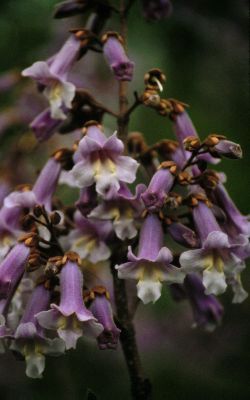Genus: Paulownia

Photo © by Peter Nelson
Taken at the Brooklyn Botanic Garden, NY, 1990.
Nomenclature
Paulownia Siebold & Zucc., Fl. Jap. 1: 25. 1835-1836. TYPE: Paulownia imperialis Siebold & Zucc. (=Paulownia tomentosa (Thunb.) Steud.).List of Paulownia Species
References to Paulownia
- Ambler, M. A. 1965. Seven alien plant species. William L. Hutcheson Memorial For. Bull. 2: 1-8.
- Borthwick, H. A.; Toole, E. H.; Toole, V. K. 1964. Phytochrome control of Paulownia seed germination. Israel J. Bot. 13: 122-33.
- Borthwick, H. A.; Toole, E. H.; Toole, V. K. 1965. Phytochrome control of Paulownia seed germination. Israel J. Bot. 13: 122-33.
- Campbell, D. H. 1930. The relationships of Paulownia. Bull. Torrey Bot. Club 57: 47-50.
- Carpenter, S. B.; Immel, M. J.; Smith, N. D. 1983. Effect of photoperiod on the growth and photosynthetic capacity of Paulownia seedlings. Castanea 48: 13-8.
- Carpenter, S. B.; Smith, N. D. 1979. Germination of Paulownia seeds after stratification and dry storage. Tree Pl. Notes 30: 4-6.
- GuédÞs, M. 1974. The gynoecium of Paulownia and Schlegelia and the problem of the deliniation of Scrophulariaceae and Bignoniaceae. Compt. Rend. Hebd. Seances Acad. Sci. 278(21): 2629-32. (In French)
- Hu, S. Y. 1959. A monograph of the genus Paulownia. Quart. J. Taiwan Mus. 12: 1-54.
- Hu, S. Y. 1961. The economic botany of the Paulownias. Econ. Bot. 15: 11-27.
- Kuppinger, D. M. et.al. 2010. Predicting the post-fire establishment and persistence of an invasive tree species across a complex landscape. Biological Invasions 12: 3473-3484.
- Manning, S. D. 2000. The genera of Bignoniaceae in the southeastern United States. Harvard Papers in Botany 5: 1-77.
- Millsaps, V. 1936. The structure and development of the seed of Paulownia tomentosa. J. Elisha Mitchell Sci. Soc. 52: 56-75.
- Moore, J. E.; Lacey, E. P. 2009. A comparison of germination and early growth of four early successional tree species of the southeastern United States in different soil and water regimes. Amer. Midl. Naturalist 162: 388-394.
- Olmstead, R. G. et.al. 2001. Disintegration of the Scrophulariaceae. Amer. J. Bot. 88: 348-361.
- Rickson, F. R. 1968. Anatomy, histochemistry and fine structure of the germinating embryo of Paulownia tomentosa. Amer. J. Bot. 55: 280-90.
- Sanderson, K. D. 1972. Effect of photoperiod on the growth of empress tree (Paulownia tomentosa) seedlings.
- Spangler, R. E.; Olmstead, R. G. 1999. Phylogenetic analysis of Bignoniaceae based on the cpDNA gene sequences rbcL and ndhF. Ann. Missouri Bot. Gard. 86: 33-46.
- Stearns, J. L. 1944. Paulownia as a tree of commerce. Amer. Forests 50: 60-1, 95-6.
- Tang, R. C.; Carpenter, S. B.; Wittwer, R. F.; Graves, D. H. 1980. Paulownia- a crop tree for wood products and reclamation of surface-mined land. S. J. Appl. Forest. 4: 19-24.
- Toda, R.; Isikawa, H. 1952. Effect of diffused light on the germination of Paulownia seeds. J. Jap. Forest. Soc. 34: 250.
- Webster, C. R. et.al. 2007. Invasion biology and control of invasive woody plants in eastern forests. Native Plants J. 8: 97-106.
- Williams, C. E. 1993. The exotic empress tree, Paulownia tomentosa: an invasive pest of forests? Natural Areas Journal 13: 221.
- Williams, C. E. 1993. Age structure and importance of naturalized Paulownia tomentosa in a central Virginia streamside forest. Castanea 58: 243-9.